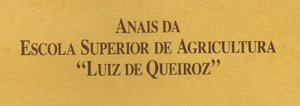Resumo
In this paper the authors have studied the manganese absorption by the sugar cane plant, variety Co 419, in samples cut monthly, from the 6th to 15th month of life in the climate prevailing at Piracicaba, State of Sao Paulo, Brazil. From October to February (6 th to 10 th month of the plant life), which coincided with the rainy season, the manganese content was higher in the stalk than in the leaves, for both treatments, fertilized and unfertilized. There was a sharp decrease in manganese content in the stalks, after February, in both reatments. In the leaves there was little variation in manganese content throughout the plant tissue. The stalks from the unfertilized plots had a larger variation in manganese content, specially from the 6 th to the 10 th month. In the leaves of the sugar cane from the unfertilized plots, the manganese content varied from 116 to 220 ppm, whereas in the fertilized treatments thire was a variation from 150 to 220 ppm. From these results, althoug not being a foliar analyses, and considering the easy availability of manganese in acid soils, there must be enough of it, if we consider 40 ppm (EVANS, 1955) as a minimum for healthy plants.
A absorção do manganês pela cana de açúcar, Co 419, em função da idade* * Trabalho realizado com auxílio da Fundação Rockfeller e CNPq.
D. Pellegrino; R.A. Catani; H. Bergamin Filho; N.A. da Glória
E. S. A. "Luiz de Queiroz"
SUMMARY
In this paper the authors have studied the manganese absorption by the sugar cane plant, variety Co 419, in samples cut monthly, from the 6th to 15th month of life in the climate prevailing at Piracicaba, State of Sao Paulo, Brazil.
From October to February (6 th to 10 th month of the plant life), which coincided with the rainy season, the manganese content was higher in the stalk than in the leaves, for both treatments, fertilized and unfertilized. There was a sharp decrease in manganese content in the stalks, after February, in both reatments. In the leaves there was little variation in manganese content throughout the plant tissue. The stalks from the unfertilized plots had a larger variation in manganese content, specially from the 6 th to the 10 th month. In the leaves of the sugar cane from the unfertilized plots, the manganese content varied from 116 to 220 ppm, whereas in the fertilized treatments thire was a variation from 150 to 220 ppm.
From these results, althoug not being a foliar analyses, and considering the easy availability of manganese in acid soils, there must be enough of it, if we consider 40 ppm (EVANS, 1955) as a minimum for healthy plants.
Texto completo disponível apenas em PDF.
Full text available only in PDF format.
Recebido para publicação em 8/8/1962.
- CATANI RA. et al. A absorção de Nitrogênio, Fósforo, Potássio, Cálcio, Magnésio, Enxofre e Silício pela cana de açúcar, Co 419, e o seu crescimento em função da idade. An. E.S.A. "Luiz de Queiroz" XVI: 167, 1959.
- EVANS, H. - Studies in the Mineral Nutrition of Sugar Cane in British Guiana - II: The Mineral Status of Sugar Cane as Revealed by Foliar Analysis. Trop. Agric. 32, (4): 310, 1955.
- ERKAMA, J. - On the Effect of Copper, and Manganese on the Iron Status of Higher Plants. In Trace Elements in Plant Physiology. Chronica Botanica Company, 1950. pp. 53-62.
- JOHNSON, CM. & ULRICH, A. - Bull. Calif. Exper. Stat. 766: 71, 1959.
Datas de Publicação
-
Publicação nesta coleção
11 Set 2012 -
Data do Fascículo
1962

